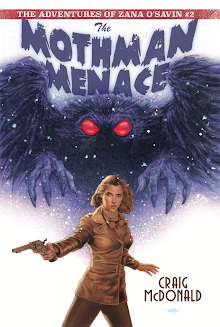 |
| The cover for the new Betimes Books' release of ONE TRUE SENTENCE. |
In terms of original publication sequence, ONE TRUE
SENTENCE, is the fourth in my series centered on a crime novelist and sometimes
screenwriter named Hector Lassiter. Chronologically, however, it is the
first — depicting Hector as a young writer searching for his voice.
Hector first appeared in long form in my debut novel HEAD GAMES (2007). I thought I’d written a standalone novel. I next moved onto a
contemporary thriller about illegal immigration eventually published as EL GAVILAN (2011).
But then I soon revisited Hector for a novel called TOROS
& TORSOS.
At the time that T&T was freshly completed, HEAD GAMES
wasn’t yet published, wasn’t even sold — dwelling in a kind of limbo and
stubbornly unread by its eventual first publisher Ben LeRoy.
Despite that fact, when the manuscript for Lassiter #2 was
completed, my then-agent and I agreed T&T, written in a pulp-frenzy style
of less than three months, represented a kind of artistic corner-turning and
leap forward: it demanded a follow up novel with Hector that would build on the
mood and dark literary and metafictional undertow established in T&T.
Looking for ideas, I took a week and dusted off a manuscript
about the suicide of Ernest Hemingway I was then calling PAPA’S LAST WIFE. With
my agent’s blessing and encouragement, I quickly rewrote what was then a novel
about a young writer named Hannah Paulson to insert Hector Lassiter into the
book (a novel subsequently published in 2010 under the title PRINT THE LEGEND).
To my mind, PTL was a novel I’d publish toward the end of any Hector Lassiter
series, if we ever got that far. For me, PTL didn’t seem quite the proper follow up to T&T. I wanted it to be the
next-to-last novel featuring Hector.
With New Year’s Day looming, I continued to cast around for
what I could regard as the one true follow up to TOROS & TORSOS. I spent
those closing days of the year revisiting favorite books and biographies;
listening to old favorite music and surfing the net for odd scraps of history
nobody had yet plundered for plot lines. Call it prospecting for inspiration: I
needed a dark, enticing muse for this new, still unthought-of novel.
On TV, in the background, Country Music Television was
playing. Typically that channel just pours out videos by the usual suspects
who’ve made contemporary country music feel too much like a wasteland. But that
hour’s program was something different
— a fleeting leap into cutting edge music in which up-and-coming or avant-garde
folksingers and country musicians, quirky singer-songwriters, were showcased.
This particular music video bounced for me: The song was
entitled “Passenger 24.” It opens with a driving piano, then quickly brings in
some drum work. Then its story
unfolds: A rider on a bus with a bag stuffed with cocaine who’s “Left a girl in
Amarillo, about as sweet as rum.”
The singer/songwriter was this siren songstress named Melissa McClelland. As her song unreeled against images of Old Route 66 — a tune rife
with noir undercurrents — I swung by Melissa’s website. Seemed she’d trucked
with Sarah McLachlan for several years. The tune that so engaged me was from
Melissa’s new album called, “Thumbelina’s One Night Stand.”
I grabbed that album; took the plunge.
HEAD GAMES grew out of obsessive listening to select Tom Russell songs and albums — an influence so key to that novel’s creation I ended
up dedicating HG to Russell for “providing its soundtrack.”
“Thumbelina’s One Night Stand” fulfilled the same function
for me. What I regarded as Hector Lassiter number 3, a book I was then calling
CITY OF LIGHTS, grew directly out of the inspiration of Melissa’s album — a
cycle of songs about unrequited love, self-destructive passion and, ahem…suicide.
 |
| The cover for the original U.S. release of ONE TRUE SENTENCE, painted by Echo Chernick |
Song’s like “Solitary Life,” sung from the perspective of a
woman in her coffin (“brooding just beneath the varnished pine/wicked smell of
death and turpentine”) and “You Know I Love You Baby” (“You look like me/I look
like hell”) suggested characters and motivations that wove their way into the
plot of a book I saw as a study of 1920s Paris and its rampant artistic
nihilism, a novel in which we would observe Hector Lassiter move from aspiring literary
writer to crime novelist; a novel in which Hector would engage the most
compelling and influential woman in his storied life.
Some writers are inspired by other writer’s books.
Some find their muse in movies.
For me, music has always been the touchstone for creation.
Other novelists have certainly influenced me, even inspired
me, but forced to point to those who truly
shaped my own writer’s voice, I’d point in directions other than the usual
crime and mystery fiction suspects.
I learned more about the craft and strategy of putting words
together from Kris Kristofferson, Mickey Newbury and Jimmy Webb than Hammett
and Chandler.
For better or worse, Hemingway certainly left his mark on me
as a writer, but to an arguably greater degree, so did Kristofferson.
ONE TRUE SENTENCE may read like A MOVEABLE FEAST recast as a
crime novel, and in a way that’s true, so far as it goes. But OTS wouldn’t
exist without the inspiration of a certain Chicago-born singer songwriter
sometimes likened to a “female Tom Waits.”
Gracias, Melissa.






































No comments:
Post a Comment